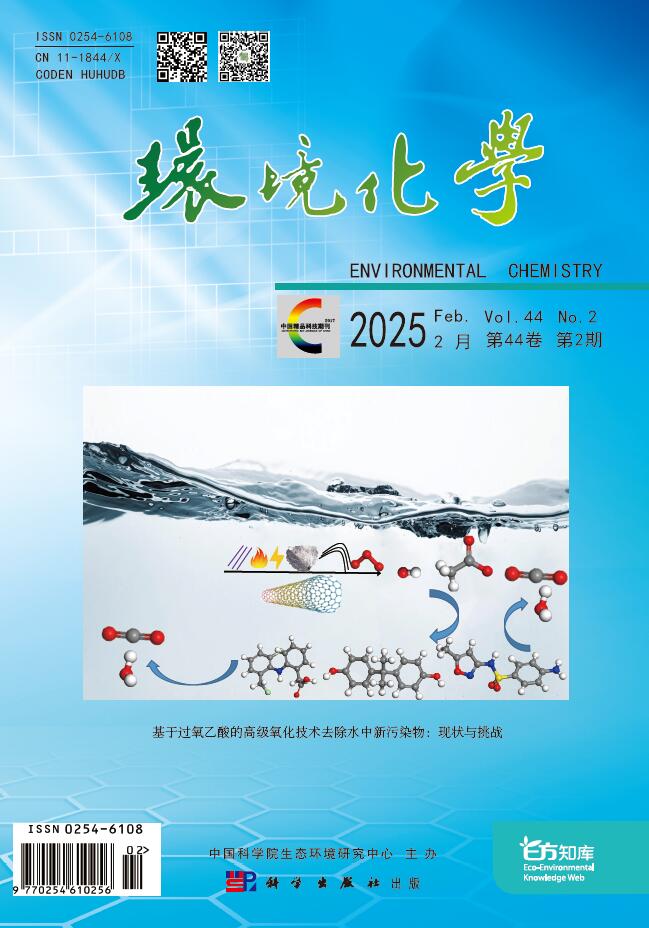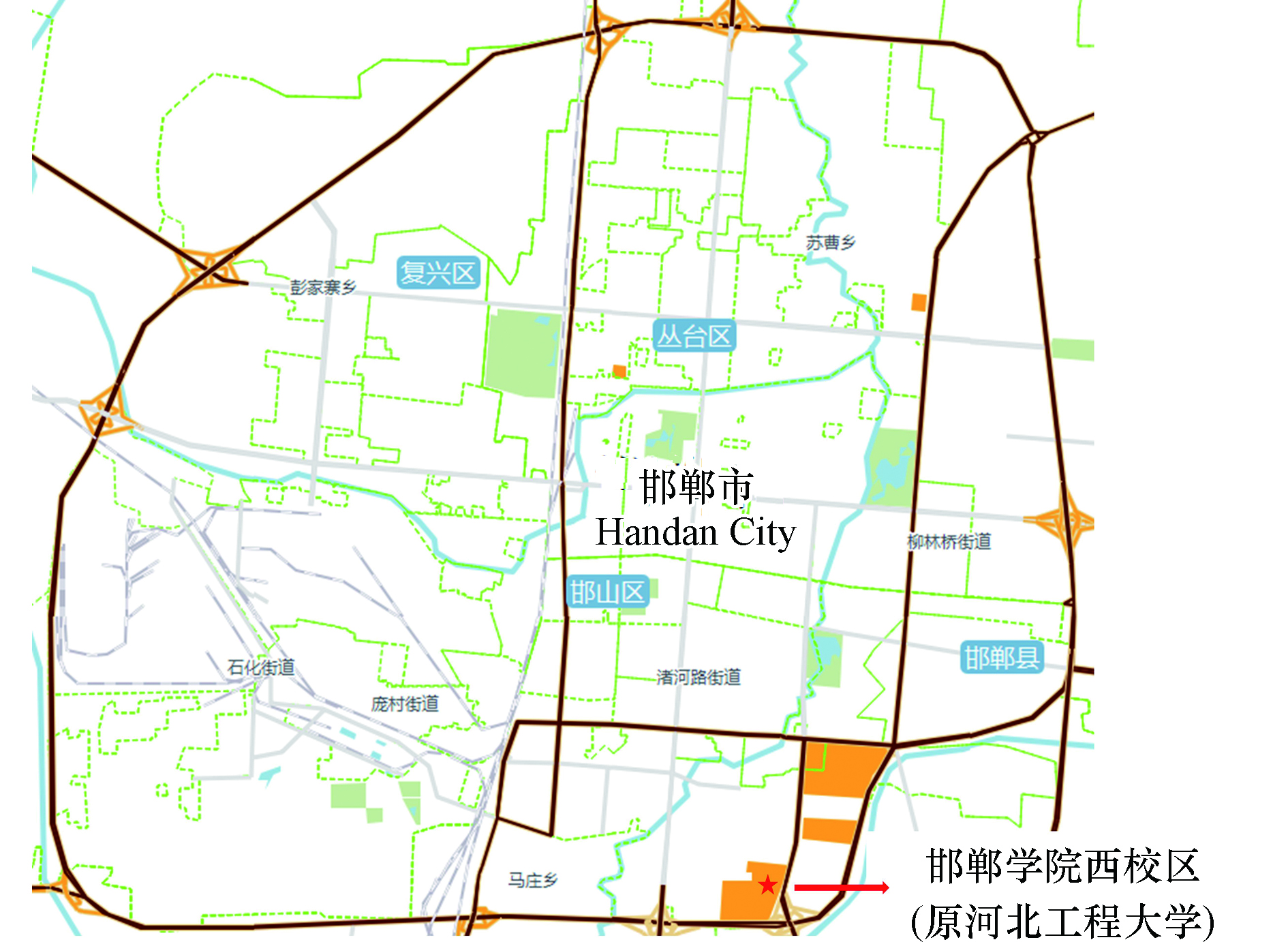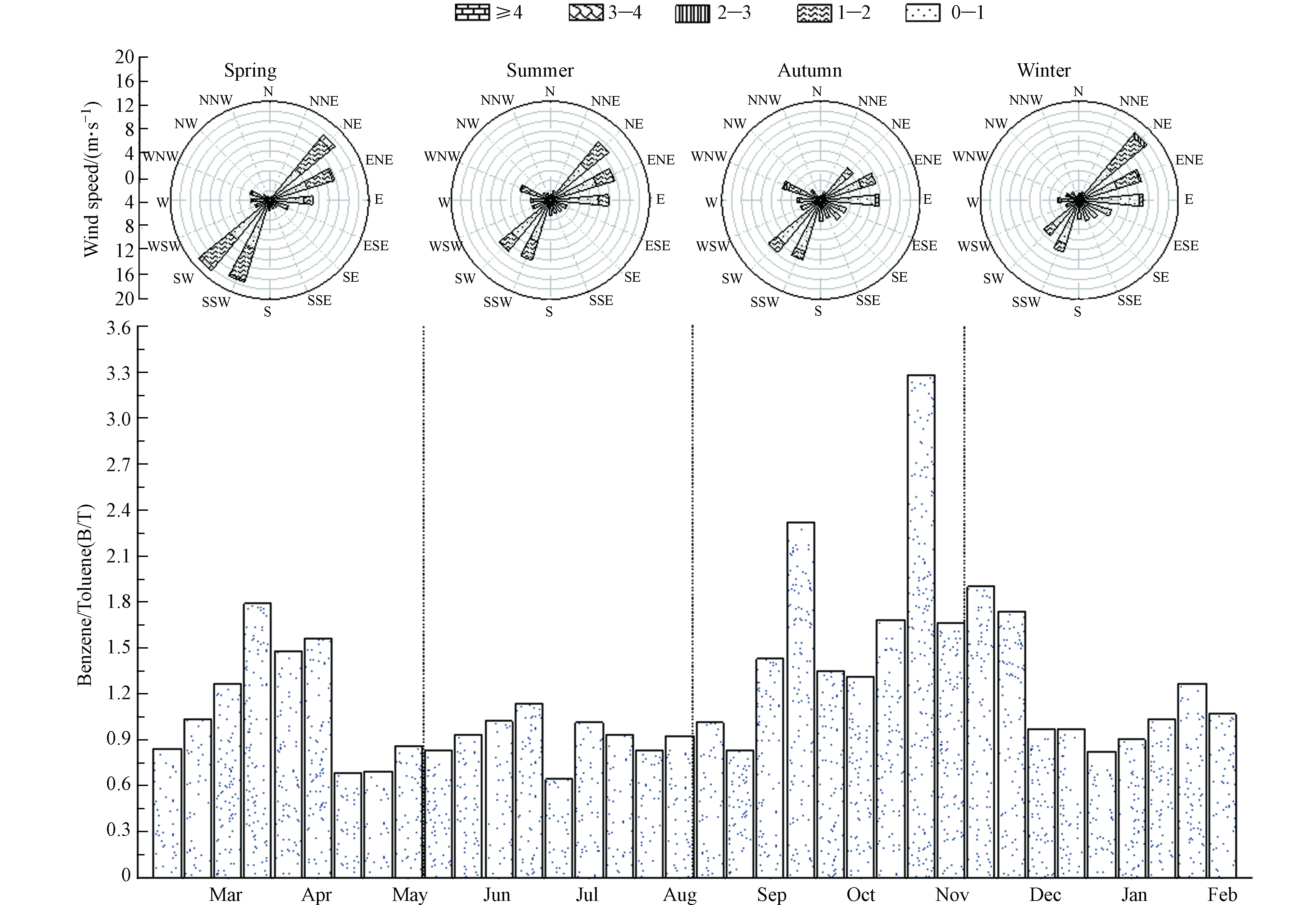-
苯系物(BTEX)是挥发性有机污染物(VOCs)中含量较高的一类,在常温下蒸发速率大、易挥发[1],且具有较高的化学反应活性,是环境空气中臭氧(O3)和二次有机污染物(SOA)的重要前体物。苯、甲苯、乙苯、间、对-二甲苯和邻-二甲苯是苯系物中的主要污染物,通常可以代表苯系物来研究其污染特征,其来源主要与石油化工产品、产业相关[1]。长期暴露在环境空气中的BTEX下会刺激人体皮肤和粘膜,同时对人体的呼吸系统、造血系统和神经系统等造成一定的损害[2],而且BTEX具有一定的致癌风险。
随着我国城市化进程的加快,环境中有毒有害污染物增多,已经对人类赖以生存的生态环境造成严重冲击。由于BTEX对环境的显著效应以及对人体的健康效应,许多学者对其进行了研究。近年来,对BTEX的研究多集中在北京、南京等发达城市,杨婷等[3]研究指出对北京臭氧和二次有机气溶胶生成贡献最大的组分是苯和甲苯,苯的致癌风险远超美国环保署(US EPA)提供的安全阈值。王宇亮等[4]采用Tenax-TA/吸附热解吸、光离子化气相色谱法(GC-PD)研究北京苯系污染物的主要污染源为机动车排放。张玉欣等[5]研究指出南京周末BTEX浓度升高主要是由机动车排放量增加导致的,且本地源对南京污染水平影响最大。通过对健康风险的来源分析后发现,机动车排放是致癌风险最高的来源。赵若杰等[6]研究表明,苯系物的污染浓度与气候变化息息相关。
邯郸大气污染严重,空气质量在中国生态环境部发布的《2018年中国生态环境状况公报》(http://www.mee.gov.cn/hjzl/)中规定的169个新标准重点监测城市中倒排第五。Wang等[7]基于CMAQ模型对河北省PM2.5进行源解析,孟琛琛等[8]研究了河北省细颗粒物(PM2.5)浓度及水溶性无机离子的特征,鲁晓晗等[9]分析了VOCs的污染特征及O3和SOA生成潜势,但并未对BTEX进行深入分析,针对邯郸市BTEX的研究仍然十分缺乏。邯郸市高校区人群密度大且流动性较差,环境空气中的BTEX浓度严重影响人体健康及环境空气质量,因此对邯郸市高校区开展BTEX的特征研究具有重要意义。
HTML
-
邯郸位于河北省最南端,西依太行山脉,东接华北平原,是晋、冀、鲁、豫的四省交界之处,华北地区重要的交通枢纽。本监测站位于邯郸市高校区邯郸学院西校区(原河北工程大学)实验楼4楼楼顶(36°57′N,114°50′E),海拔高度为56.4 m,距离地面10 m左右,为典型的居民文教混合区,站点周边两公里内无明显排放源及高层建筑遮挡物,监测结果具有代表性,具体位置如图1所示。监测时段为2018年1月1日至12月31日,共获得有效样本8158个。
-
本研究采用德国AMA公司研制的GC5000型挥发性有机物在线监测系统,该仪器参照美国环保署PAMS标准,适于挥发性有机物中C2—C12碳氢化合物的长期监测,具有10−12级检测灵敏度。该仪器的核心设备主要有3部分:GC5000 VOC分析色谱(目标化合物C2—C6),GC5000 BTX分析色谱(目标化合物C6—C12),DIM200 动态校准器(最大稀释倍数2500倍),检测部分系统时间分辨率为1 h。该设备以高纯氮为载气,以高纯氢为助燃气,经气体预处理装置(净化载气和助燃气)处理后,通过检测器FID对环境气体进行定量分析,可以24小时连续采样,同时监测56种VOCs。本研究选取其中的苯、甲苯、乙苯、间、对-二甲苯和邻-二甲苯作为研究对象。监测期间每月用PAMS标准气体(56种混合标样)及高纯氮对仪器进行校准,并按时清洗仪器,更换硅胶、滤膜、超纯水等耗材,以保证仪器数据的可靠性。
-
(1)O3生成潜势及各组分反应活性计算
OFP计算公式:
式中,MIR(maximum incremental reaction)为BTEX中第i种组分在生成O3过程中的O3生成系数[10];Ci为该组分污染物的环境浓度,µg·m−3。对每种污染物的OFP(ozone formation potential)加和即可得到BTEX的O3生成潜势。
(2)二次有机气溶胶生成潜势的计算
本研究基于Grosjean等[11-12]的烟雾箱实验结果,利用FAC(formation aerosol coefficient)对大气中BTEX生成二次有机气溶胶的过程进行估算,SOAFP的计算公式为:
式中,SOAFP(secondary organic aerosol formation potential)是二次有机气溶胶的生成潜势,µg·m−3;VOCs0是排放源排放的污染物初始浓度,µg·m−3;FAC是SOA生成系数。由于考虑到站点监测到的数据是氧化后的VOCst,故通过下式计算排放源排放的初始浓度值VOCs0:
式中,FVOCr是VOCs组分中参与反应的分数。
-
(1)非致癌风险评价
非致癌风险评价用危害指数HI表示,指由于吸入途径暴露造成的摄入量与参考计量的比值[13]。参考Li等[14]的研究方法,通过每日的暴露计量来预测长时间暴露时是否会产生危害的效应。
慢性每日进气量为:
非致癌风险危害商值:
危害指数是多种污染物的危害商值之和:
(2)致癌风险评价
致癌风险评价由风险值R(risk)表示,通过参考摄入量(或致癌强度系数)与每日平均摄入量的乘机来表示。风险值计算公式为:
式中各字母分别为:CA(contaminant concentration in air)为环境浓度,µg·m−3;CF(conversion factor)为转换因子,mg·µg−1;IR(inhalation rate)为吸收速率,这里取中国成年人平均呼吸率,男性约为19 m3·d−1,女性约14 m3·d−1;EF(exposure frequency)为暴露频率,这里取270 d·a−1[15];ED(exposure duration)为暴露时间,4 a;AT(averaging time)为终生暴露时间,365×我国成年人平均寿命,男性取69.6 a,女性取73.3 a;BW(body weight)为暴露者体重,这里取中国成年人平均体重男性为62.70 kg,女性为54.40 kg;CDI(chronic daily intake)为慢性每日进气量,mg·(kg×d)−1;CSF(carcinogenic slope factor)是致癌因子,mg·(kg×d)−1。
研究中需要的IR、AT、BW等参数值取自中国人群暴露参数手册(成人卷)[16];Rfc(reference concentration)参数可在美国环保署综合风险信息系统(IRIS)数据库(http://www.epa.gov/iris)中查到。表1为上述计算过程中各组分污染物的计算参数。
1.1. 站点信息
1.2. 监测设备
1.3. O3和二次有机气溶胶生成潜势
1.4. 健康风险评价方法
-
邯郸市高校区2018年BTEX平均浓度为12.92 µg·m−3,甲苯是全年浓度最高的污染物,平均浓度为4.39 µg·m−3。表2对比了邯郸市高校区和其他城市大气环境中BTEX的浓度水平,夏季BTEX平均浓度低于2012年夏季的天津和唐山,冬春季节BTEX高于同一时期的兰州,就全年平均浓度来看,BTEX浓度高于2013年3月—2014年2月的南京,低于2014年的北京和2008年的沈阳,总体来看,在国内城市属于中等污染水平。与国外城市相比,春季浓度低于2013年曼谷、高于2009年埃斯基谢希尔,秋季浓度低于2013年新德里,夏冬季平均浓度低于2015年亚兹德,就全年平均浓度来看,低于2011年曼谷、2009—2010年阿利亚加、2013—2014年新德里。由于邯郸产业结构以电力、钢铁等重工业为主,市区空气质量受工业源影响[9],苯和甲苯的年均比值(B/T)为1.21,低于南京、兰州、唐山,高于其他3个国内城市。装修过程中所使用的有机溶剂及有机胶黏剂也会排放大量苯系物,但站点周边1 km无新建建筑物,装修需求较少,且根据B/T值可见,居民装修对站点附近空气质量影响较小。其余城市中,工业区的传输污染是唐山站点的主要来源[19],交通排放对北京[3]、天津[20]的影响最大。值得注意的是由于监测时间、仪器以及气象因素等的不同,对比结果存在一定误差,这里仅用作浓度水平的初步判断。
-
图2为BTEX小时平均浓度,总体来看,人为活动对其有较大影响。上班早高峰及清晨时有发生的大气逆温现象导致工作日BTEX浓度在6:00左右开始升高,8:00左右出现峰值(17.25 µg·m−3)。随着光照的增强,大气混合层高度升高,环境空气中的光化学反应逐渐强烈,9:00之后浓度开始下降,在14:00—16:00之间出现谷值,谷值约为8.20 µg·m−3。伴随下班晚高峰的排放,BTEX浓度开始回升,夜里光化学反应减弱,浓度累积,直至第二日清晨达到峰值。周末和工作日的浓度特征基本相似,小时平均浓度(13.31 µg·m−3)高于工作日(12.76 µg·m−3),但周末不具有明显的早高峰特征。图2给出了工作日与周末污染物浓度比值,与汽车排放相关的污染物苯和甲苯周末浓度升高较明显,其比值分别为0.96和0.94,间、对-二甲苯次之,为0.97。分析上述后可发现,周末污染升高可能与机动车出行较多有关,同时光照,气象条件以及污染源差异等也对小时平均浓度有重要影响。
图3中BTEX污染浓度呈现冬季>秋季>春季>夏季的特征,主要是由于秋冬季节大气混合层高度较低,相较于春夏季的低温低湿,不利于污染物的扩散[29-30],以及冬季采暖期排放更多BTEX等原因。各组分中与机动车排放相关的甲苯浓度占比较大,且具有明显的季节变化特征,全年平均污染浓度为4.39 µg·m−3,相对而言夏季占比较小(29.70%),秋、冬季节占比较高(37.73%、37.71%)。乙苯变化规律与甲苯相反,溶剂、涂料等的挥发[31]使夏季浓度占比升高(13.35%),邯郸市2018年推出秋冬季减排方案后,各行业排放标准更加严格,乙苯浓度占比降低,秋冬季占比分别为7.82%和8.91%,全年平均浓度为1.84 µg·m−3。苯和二甲苯各季节浓度占比变化较小,年均浓度为3.88 µg·m−3、2.81 µg·m−3。
-
监测期间,邯郸市高校区年均O3生成潜势(OFP)为46.34 µg·m−3,各季节BTEX的OFP值均表现为甲苯>间、对-二甲苯>邻-二甲苯>乙苯>苯(如图4(a))。总体来看,BTEX的OFP与浓度特征相似,表现为冬季最大,为57.06 µg·m−3,秋季(51.18 µg·m−3)次之,夏季和春季较低,分别为39.77 µg·m−3和38.68 µg·m−3,不同之处在于春季BTEX浓度高于夏季,而夏季OFP值高于春季,由图4(a)浓度和OFP对比可发现,二甲苯(间、对-二甲苯、邻-二甲苯)年均浓度较低,但生成O3的能力远高于其他物种,且夏季二甲苯浓度高于春季,因此产生这种差异。
甲苯是BTEX中浓度最高的组分,年均OFP值占BTEX的38.07%,二甲苯和甲苯OFP之和占81.05%,是生成O3的优势物种,这与管贤贤等的研究结果一致[21],因此在治理邯郸市环境空气中近地面O3污染时,应着重控制这些优势物种。
-
本研究采用Grosjean等[12]提出的气溶胶生成系数法估算大气中BTEX的SOAFP,认为6碳及以下的低碳分子因饱和蒸气压太高无法形成SOA,但是Martin-Reviejo等[32]研究发现苯的二级氧化产物也是SOA的前体物,产率在8%—25%之间,苯是邯郸市高校区BTEX的第二大组分,不能忽略其对SOA生成的影响,故取吕子峰等实验中苯的FAC值为2%[33]。
图4(b)计算了各季节BTEX对SOA的生成贡献,计算过程中忽略环境因素及其他途径在反应过程中产生的影响,估算值略低于实际值[12],这里只研究其特征。SOAFP的季节变化为冬季>秋季>夏季>春季,年平均为0.67 µg·m−3,春、夏季各物种的变化特征相同,表现为甲苯>乙苯>间、对-二甲苯>邻-二甲苯>苯,平均SOAFP分别为0.56 µg·m−3、0.57 µg·m−3;秋、冬季的变化特征为甲苯>间、对-二甲苯>乙苯>苯>邻-二甲苯,平均SOAFP分别为0.73 µg·m−3、0.83 µg·m−3。甲苯年均SOAFP为0.27 µg·m−3占BTEX贡献量的40.30%;苯为0.09 µg·m−3占12.91%;二甲苯的SOAFP为0.20 µg·m−3占29.28%,远低于对OFP的贡献。二甲苯对O3和SOA生成潜势表明BTEX生成不同二次污染物的能力存在差异,治理过程中对于不同类型的污染应区别对待,这对大气污染物治理具有一定的指导意义。
-
通过分析BTEX各组分间的相关性,可以简要的阐明BTEX的可能来源,本研究在0.01的水平上计算了各组分间的相关性。观测期间,间、对-二甲苯和邻-二甲苯的相关性系数为0.93,二者具有较好的同源性,故将二者合并为二甲苯。工业溶剂是二甲苯的主要污染源[34],除夏季外,二甲苯和乙苯在各个季节都具有较好的相关性,其中秋冬季最高,相关性系数为0.8—0.9,说明工业源对二者贡献较大。乙苯与苯和甲苯的相关性系数不足0.4,说明乙苯与二者不具备相关性。除此以外,苯与二甲苯的相关性较低(0.55),这可能与二者的光化学活性有关,二甲苯的光化学活性远高于苯,导致它们在空气中的降解速率不同[35],相关性较差。
由于相同的物理混合、光化学去除过程会引起相同的浓度变化,则两种组分污染物在大气中的浓度比值等于其在排放源中的比例,由此可以判断污染物的来源[36]。苯与甲苯的比值(B/T)常用来识别BTEX的来源,当B/T为0.6左右时,交通排放是主要污染源[37],涂料及溶剂挥发会导致该值小于0.6;B/T为2.7左右,表示工业燃煤是VOCs的主要污染源[38]。如图5所示,B/T的年平均比值为1.21,介于2.7和0.6之间,全年污染物由交通源和工业源等多种污染源共同影响,这可能与邯郸以钢铁生产为主的产业类型有关。图中秋冬季节B/T值高于春夏,与浓度特征相似,秋季该比值最高,由风玫瑰图可知,相较其他季节秋季盛行西北风,且风速较大,西北方向工业区的输送对站点影响较大,这与二甲苯和乙苯相关性分析结果较吻合;春季西北向风速较低、风频较小,对工业区污染物的输送能力有限,且由比值可知,春季该比值最低,浓度受机动车排放影响较大。
-
监测站点位于大学校园内,本研究主要评估BTEX对大学生在校四年的健康风险(图6)。通过计算非致癌风险商值(HQ),危害指数(HI)以及致癌风险(R),并运用Crystal ball软件对其进行蒙特卡洛模拟,经10000次运算后取平均值以及10%—90%概率内的风险值,对BTEX进行健康风险评估。各组分中HQ最高的是苯,平均值为男性4.62×10−3,女性3.99×10−3,HQ值集中在1.19×10−3—9.21×10−3,最高没有超过US EPA规定的安全阈值1,其余各组分对男(女)性的平均HQ值为:二甲苯9.98×10−4(8.83×10−4)、乙苯6.70×10−5(5.79×10−5)、甲苯7.69×10−6(6.72×10−6)。BTEX的平均HI为5.73×10−3(4.98×10−3),其值主要集中在2.08×10−3—1.03×10−2,不会引发人体不适。
苯是国际致癌机构公认的I类致癌物,US EPA研究表明痕量的苯对人体亦有较高的致癌风险,乙苯也有一定的致癌性,故本研究对苯及乙苯的致癌风险进行评估。根据Hadei等[39]的研究,将R>1×10−4定义为明确的致癌风险,1×10−4—1×10−5定义为较大概率的致癌风险,1×10−5—1×10−6定义为可能的致癌风险,R<1×10−6定义为可忽略的致癌风险。US EPA同样将1×10−6定义为安全阈值。计算后发现各季节乙苯对在校大学生的R值均小于1×10−6,属于可忽略的致癌风险。苯的致癌风险相对较高,男性全年均存在可能的致癌风险,其中冬季最高,R值落在3.09×10−7—2.54×10−6区间内,平均值为1.25×10−6,夏季致癌风险较低,R值集中在1.45×10−7—1.07×10−6,平均值5.38×10−7。除夏季外,各季节对女性均存在可能的致癌风险,其中冬季最高,R值集中在2.73×10−7—2.21×10−6,平均值为1.10×10−6,年均R值集中在1.52×10−7—1.49×10−6,平均值为7.12×10−7。由于大学校园人口来源广泛,本研究参考环保部2013年发布的《中国人群暴露参数手册》中全国成年人(18—44岁)的平均暴露参数,男性呼吸率(18.4 m3·d−1)远高于女性(14.6 m3·d−1),理论计算可知男性具有较高的致癌风险,各季节中冬季致癌风险最高,在校大学生应提高防护意识。
2.1. 浓度特征
2.1.1. 邯郸市高校区BTEX污染水平
2.1.2. BTEX浓度变化特征
2.2. BTEX的光化学反应活性分析
2.2.1. BTEX对O3生成的潜在贡献
2.2.2. 二次有机气溶胶生成潜势
2.3. BTEX的比值及来源识别
2.4. 健康风险评估
-
(1)邯郸市高校区2018年BTEX平均浓度为12.92 µg·m−3,与国外其他城市相比仅高于埃斯基谢希尔,在国内也处于中度污染水平。季节变化表现为冬季>秋季>春季>夏季,与工作日相比,周末苯和甲苯平均浓度升高,机动车排放是周末污染物浓度较高的主要来源。
(2)分别应用最大增量反应法和气溶胶生成系数法计算得到BTEX对O3、SOA的生成潜势分别为46.34 µg·m−3、0.67 µg·m−3。
(3)除乙苯与苯、乙苯与甲苯外,其他各组分间都具有较好的相关性。比值分析后发现B/T的值为1.21,介于机动车排放(0.6)和工业源(2.7)之间,BTEX浓度由两种污染源共同影响。
(4)针对站点附近在校大学生进行健康风险评估,BTEX的非致癌风险商值均小于安全阈值1;乙苯对在校大学生会产生可忽略的致癌风险,苯会产生可能的致癌风险。











 DownLoad:
DownLoad:
